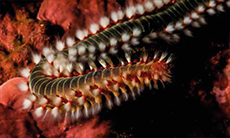




| Home | Features | Club Nights | Underwater Pics | Feedback | Non-Celebrity Diver | Events | 18 July 2025 |
| Blog | Archive | Medical FAQs | Competitions | Travel Offers | The Crew | Contact Us | MDC | LDC |

|

|
 
 |
 ISSUE 23 ARCHIVE - BEARDED FIREWORMMads AndersonHi! My name's Mads, and I'm 17 years old. I learnt to dive when I was 12 years old, now I am a PADI Master Scuba Diver, ISE Sidemount Diver and TDI Intro to Cave Certified. I am currently studying for my A-Levels (Biology, Physics and Maths) and in September will be off to University to study Marine Biology!The Hermodice carunculata or the "Bearded Fireworm" is a species of Marine Bristleworm native to the tropical Atlantic Ocean and the Mediterranean Sea. The Bearded Fireworm is a spectacularly multi- coloured patterned worm that can reach up to 35cm in length (but more commonly 7-10cm). They are abundantly found on reefs, in rocky areas and in areas of seagrass. They have also previously been found in flotsam and up to depths of at least 60m. Apart from the head and tail segments, all sections along the worm are identical. Each part has a pair of "paddles" (called parapodia) used for swimming, burrowing and creating a feeding current. Along both sides of its body are groups of long white bristles which flare out defensively if the worm is disturbed. These bristles are very sharp, penetrate flesh extremely easily and once embedded shred readily off the worm. The worm is fairly slow moving and not considered a threat to humans, however the bristles are hollow on the inside and filled with venom. The sting can lead to an intense feeling of irritation, a burning sensation and may even cause nausea and dizziness. The effects can last for a few hours but a painful tingling may remain after that. The "fire" part of their name therefore comes as no surprise. So why write an article about the Bearded Fireworm, of all things? This little worm was a topic of much discussion during my 'Intro to Cave' course in Gozo during the summer. They seemed to be everywhere! This is more than slightly concerning when you are blindfolded in a cave doing drills. Surprisingly it becomes a little more difficult to avoid touching the dear fireworms when you can't see anything. One day after having come across many fireworms during one such dive in the cave, my instructor, Audrey, wondered out loud: "What eats these fireworms? Do they have predators? They seem to be everywhere, but I've never seen one being eaten!". Considering I want to go to university in September to study Marine Biology. I was sent off that evening with some homework - find out what (if anything) eats this Bearded Fireworm! The following day I was able to report back to Audrey and my team mate, Richard, with some very positive news... There are in fact a few things in existence that do eat this dreaded bristleworm! The main predator I found was the Cone Snail (genus Conidae). Cone snails are extremely sophisticated predatory sea snails. They hunt and immobilise prey using a radular tooth (found in many species of mollusc, it is simply an extremely rough tooth - to the extent that there are many tiny sharp teeth that make up this one tooth) as well as using a venom gland which contains neurotoxins (destroy nerve tissues); the tooth is launched out of the snail's mouth in a manner not too dissimilar to a harpoon. Once immobilised the snail engulfs its prey. With over 800 species of cone snails it is possible to find them all around the world. It's not uncommon in aquatics for tank owners to find Bearded Fireworms in their aquariums. On tropical marine forums it has been suggested that Arrow Crabs, Sixlines and Pseudochromis are all able to prey upon the fireworm. Arrow crabs for example are opportunistic feeders. However, it can be said with no certainty that these predators will prey upon banded fireworms in the wild. So as annoying as our dear Bearded Fireworms were for us during our dives: crawling over rocks we wanted to use as tie offs; climbing over our lines; and wrapping themselves around the handles of our reels, we can't really complain about them. They are simply scavengers doing a job that no other fish wants to do, and their numbers are (somewhat) being controlled by predators. As we are guests in their domain we just need to respect these little guys and do our best to work around them and not touch them. That both minimises stress to them and pain to us — it's a win-win situation! Photos taken by Pete Bullen Previous article « How to Excel the Physical Fitness Test at your next Diving Medical Next article » Dos and Don'ts of Diving in Japan Back to Issue 23 Index |